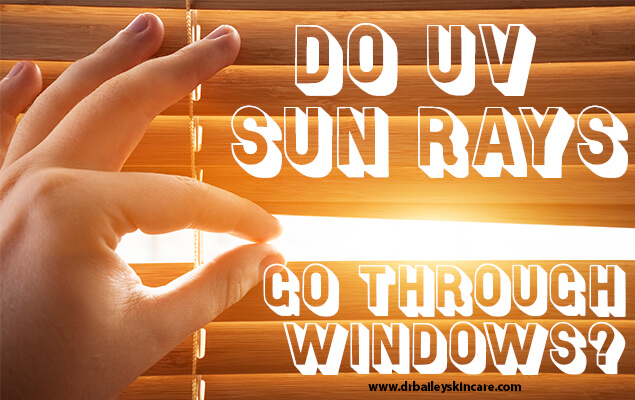
The answer is yes, usually some important UV rays do come through window glass.
Recently a reader sent me this question as a comment to one of my blog posts. It’s such a great question, and one patients often ask me, so I decided to make an Ask Dr. Bailey post out.
John asked:
Hi Dr. Bailey,
I work in a “trendy” office with floor to ceiling windows on all the outside walls. I know many commercial buildings now have UV window film that appears untinted to the human eye but block almost all UV radiation. Is there any way to tell if the window next to me has this type of filtering in place? It would save me from reapplying sunscreen at my desk every 3-4 hours!
Best Regards and love the blog!
John
Hello John,
This is a really important issue for anyone sitting in direct sunlight that comes through a window. Normal glass blocks all of UVB but allows UVA to come through. Both of these rays are harmful. Remember:
UVB
- UVB is considered the main sunburn ray
- It causes skin cancer and sun damage
- The SPF in a sunscreen tells you how well the product protects you from UVB
UVA
- Is the UV ray in tanning beds
- It penetrates the skin more deeply than UVB playing a big role in sun damage including wrinkles
- It can cause skin cancer
- The SPF on sunscreens tells you nothing about whether the product protects you from UVA. Look for sunscreens labeled ‘broad spectrum’, but even then full UVA protection is more complex. Bottom line, I recommend mineral sunscreens for the best, most reliable UVA protection (click here to read more) or Mexoryl SX if you really don’t like mineral sunscreens.
As you point out, some modern windows block most all of the UV rays including UVA. Finding out which windows were used in the construction of your building might help answer that question. It’s possible to block up to 99.9% of UV waves with today’s modern technology. In general, you can add sheets of UV blocking film to windows, or purchase glass that includes technology to block UV rays.
The Skin Cancer Foundation also has a list of window films that they have investigated and whose reliability they approve of. They also have a a glass manufacture that’s passed their muster too. Beyond that, the only way to accurately test how much UV passes through your windows would be to finding someone with a radiometer that measures the UV transmittance.
For my patients who sit in direct sunlight coming in through window glass, I recommend wearing a mineral sunscreen and clothing that blocks UV rays. If their windows claim to block UV rays I point out that a very tiny amount of UV still gets through. As I mentioned above, it’s possible to block 99.9% of UV rays, but even if their windows are that good, the 0.1% can add up at 8 hours a day, 5 days a week. Wrinkles, age spots and skin cancer just ain’t worth it!
For exposure through windows that don’t claim to block UV rays I definitely tell my patients to reapplying mineral sunscreen every 2 hours if they can’t move out of the direct sunlight. It’s also time to get creative about trying to create shade too. That would be pretty tough in a ‘trendy’ office building with floor to ceiling windows, which is what makes this question such a challenge.
You’ve asked an excellent and important question. Best of luck.
Warm Regards,
Cynthia Bailey MD, Dermatologist
